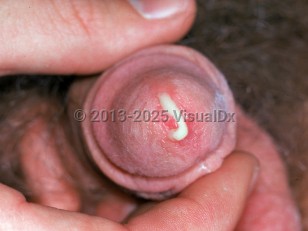Primary gonorrhea infection - Anogenital in
See also in: OverviewAlerts and Notices
Important News & Links
Synopsis

Gonorrhea is a common sexually transmitted infection (STI) caused by the gram-negative intracellular diplococcus Neisseria gonorrhoeae. It affects both males and females, most commonly individuals aged 15-24. It is highly contagious and primarily spread through sexual contact in sexually active adolescents. However, other routes of transmission are possible in children and adolescents, including via indirect contact through sharing of contaminated objects (especially in prepubescent girls), passage from an infected birthing parent to their fetus during childbirth, or sexual abuse. Notably, all children with gonorrheal infection must be screened for sexual abuse, as this is the most frequent cause in infants and children.
The incubation period of N gonorrhoeae is short. The average time from infection to symptom onset lasts approximately 2-7 days.
In boys, the manifestations are similar to those seen in adults, and the most common clinical manifestation is anterior urethritis, with purulent urethral discharge and dysuria. Complications include epididymitis, vesiculitis, and prostatitis, which occur via local extension. Epididymitis may manifest as unilateral testicular edema and pain together with the features of urethritis.
Notably, proctitis and pharyngitis occur in both sexes via direct mucosal infection, and are strongly associated with sexual assault in non-sexually active children; however, infections of the rectum and pharynx are often asymptomatic.
Neonates born to infected parents commonly manifest a purulent conjunctivitis called ophthalmia neonatorum, which is a major cause of blindness in the developing world. In the United States, the rate of this infection is low due to routine screening of birthing parents and preventive application of antibiotic ointment immediately after birth. Neonatal infection can also lead to sepsis with invasive and disseminated gonococcal infections, including meningitis and arthritis.
In children and adolescents, disseminated and invasive gonococcal infections are uncommon.
Related topics: disseminated gonorrhea, gonococcal conjunctivitis
The incubation period of N gonorrhoeae is short. The average time from infection to symptom onset lasts approximately 2-7 days.
In boys, the manifestations are similar to those seen in adults, and the most common clinical manifestation is anterior urethritis, with purulent urethral discharge and dysuria. Complications include epididymitis, vesiculitis, and prostatitis, which occur via local extension. Epididymitis may manifest as unilateral testicular edema and pain together with the features of urethritis.
Notably, proctitis and pharyngitis occur in both sexes via direct mucosal infection, and are strongly associated with sexual assault in non-sexually active children; however, infections of the rectum and pharynx are often asymptomatic.
Neonates born to infected parents commonly manifest a purulent conjunctivitis called ophthalmia neonatorum, which is a major cause of blindness in the developing world. In the United States, the rate of this infection is low due to routine screening of birthing parents and preventive application of antibiotic ointment immediately after birth. Neonatal infection can also lead to sepsis with invasive and disseminated gonococcal infections, including meningitis and arthritis.
In children and adolescents, disseminated and invasive gonococcal infections are uncommon.
Related topics: disseminated gonorrhea, gonococcal conjunctivitis
Codes
ICD10CM:
A54.9 – Gonococcal infection, unspecified
SNOMEDCT:
15628003 – Gonorrhea
A54.9 – Gonococcal infection, unspecified
SNOMEDCT:
15628003 – Gonorrhea
Look For
Subscription Required
Diagnostic Pearls
Subscription Required
Differential Diagnosis & Pitfalls

To perform a comparison, select diagnoses from the classic differential
Subscription Required
Best Tests
Subscription Required
Management Pearls
Subscription Required
Therapy
Subscription Required
References
Subscription Required
Last Reviewed:09/12/2021
Last Updated:05/12/2025
Last Updated:05/12/2025
 Patient Information for Primary gonorrhea infection - Anogenital in
Patient Information for Primary gonorrhea infection - Anogenital in
Premium Feature
VisualDx Patient Handouts
Available in the Elite package
- Improve treatment compliance
- Reduce after-hours questions
- Increase patient engagement and satisfaction
- Written in clear, easy-to-understand language. No confusing jargon.
- Available in English and Spanish
- Print out or email directly to your patient
Upgrade Today

Primary gonorrhea infection - Anogenital in
See also in: Overview
